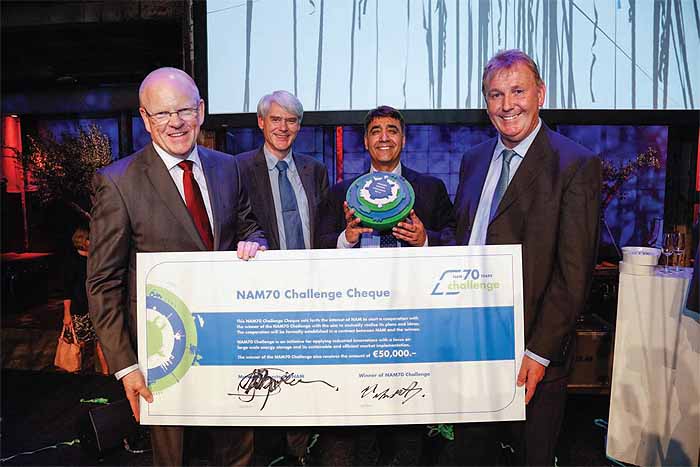Celebrating 70 Years: How NAM Became a Cornerstone of Dutch Energy
Key player in delivering energy
For over 70 years, NAM has been a major player in the Netherlands’ energy sector. The company, whose name is the abbreviation of Nederlandse Aardolie Maatschappij, which in English means Dutch Petroleum Company, was established in 1947, with the target to develop the Dutch oil field network. In 1963, NAM began to produce natural gas, four years after the discovery of the Groningen oil field, and the exploration and production of gas resources has been a key activity area for the company ever since. As of today, NAM is a close partner of the Dutch state in lots of initiatives that aim to enhance and facilitate the supply of energy across the country.
To put into perspective the central role NAM plays in the life of Dutchpeople, it should be established that the company is responsible for the supply of75 per cent of the natural gas required by Dutch households and businesses. It is also the organisation in charge of the aforementioned Groningen gas field, which is one of the world’s largest, supplying gas to 98 per cent of the population. Operating such a vast resource of natural gas has inevitably placed NAM in a strong position and, as predictions have it that natural gas will remain an essential part of the energy mix and the energy transition of the Netherlands, the company looks well-placed to remain an important player in the years to come.
Reducing emissions
As the country is entering a period of energy transition that is gradually taking a clearershape, NAM has faced a challenge to adjust its approach to some of its activities. “We are still the largest energy producer in the Netherlands with a 30 per cent market share, but this has started to decline, as the country is moving towards meeting its commitment to the Paris Climate Agreement,” NAM’s CEO, Gerald Schotman points out. An aim has been set by the House of Representatives that stipulates the Netherlands to cut its greenhouse gas emissions by 95 per cent by 2050 and  NAM is taking steps to meet the new requirements.
NAM is taking steps to meet the new requirements.
“First and foremost, it is essential that we continue to deliver energy in a safe and reliable way,” Gerald insists. “Furthermore, we are looking at our own CO2 footprint and actively seeking ways to reduce it, for example, by improving our own energy efficiency or by converting our offshore gaspowered facilities into electrically-powered plants. We believe that our knowledge of the sub-surface and our ability to execute large energy projects is of value in the energy mix of the future, as well. We also feel that geothermal energy, CO2 storage, and power-to-gas can play a role, and if this happens, we will be well-placed to be a key part of the ongoing processes.”
Innovative solution
For NAM, it is clear that one of the issues around energy transition comes from the inconsistent delivery pattern of sustainable energy. Normally, the total supply exceeds demand during the summer, whereas demand is higher in the winter months. Demonstrating proactivity again, the company launched its NAM70 Challenge on 15 January 2018 in celebration of its 70th anniversary, in which it encouraged local and international growth companies working on solutions for large-scale storage of sustainable energy to take part in the challenge and get involved in the search for more efficient ways of energy transition.
“The NAM70 Challenge is a great example of our firm belief that the leading companies of today need to work with the leading companies of tomorrow, in order to make a change,” Gerald comments. “While we work with traditional partners, we have also been increasingly collaborating with start-ups and scale-ups with adjacent business models, so that we can jointly create energy solutions.”
Three companies signed up for the NAM70 Challenge and after a unanimous decision by the jury, the proposition by the UK company, Storelectric, was announced as the winner. It has been reported that Storelectric’s innovative solution for storing renewable energy using current infrastructure, was the key factor that convinced the members of the jury. The company’s adopted technology is compressed air energy storage, which enables a surplus of wind or solar power to be stored for use when the wind is not blowing or the sun is not shining. This happens underground where the surplus energy is used to store air in salt caverns. This air is then compressed to store energy and when the energy is needed, the air is released.
Looking forward
As the winner of the NAM70 Challenge, Storelectric will receive a reward of €50,000 and implement the proposed innovation together with NAM. Gerald expresses his contentment of the successful end of the initiative and the prospect of working with Storelectric. “It is very exciting. I am delighted that we have taken a concrete step towards accelerating the energy transition in the Netherlands. The project shows that combined knowledge, expertise, and innovation helps us to move forward as a country and I am very proud of that.
“Working with new partners and the dialogue with society is more demanding than ever. Whilst we will continue to exercise our technical skills and capabilities, we also have to re-focus on collaborating with new, and sometimes very different, partners, to shape NAM for the future. Most importantly, we learn by doing, not by overanalysing, which is a common pitfall in our industry,” Gerald concludes by projecting what the future has in store for NAM.
NAM
Services: Exploration and production of oil and gas